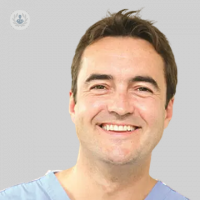Understanding your hip replacement: A guide to the different options
Written by:Patients with hip arthritis who have been recommended for hip replacement surgery may be overwhelmed by the variety of options available as well as the surgery and recovery period to come. In this detailed guide, leading consultant orthopaedic surgeon Mr Andrew Skyrme sheds light on which patients may be most suitable for the various types of hip replacement and explains the steps he takes in his own practice to ensure the best outcomes for his patients.

What different types of hip replacement are available?
Once patients have exhausted all non-operative methods to manage chronic pain, they are often offered the option of a hip replacement. Once a decision has been made to carry out a hip replacement, the patient then has to make an informed decision in association with their surgeon as to what type of hip replacement will best suit them.
There are over five hundred types of hip replacements on the market and as such it is very important that one makes the correct choice for the patient. Broadly speaking hip replacements fall into two categories; cemented and uncemented.
Both sets of implants perform exactly the same functions, that is to say they replace the damaged bone and cartilage of the ball and socket joint with a new implant. Advances in surgery and the success of hip replacements have improved dramatically over the years with lower complications and risks. I personally use a minimally invasive approach, which means that there is less tissue trauma, a smaller scar and a quicker recovery.
What is the difference between cemented and uncemented hip replacement?
Uncemented hip replacements are generally formed for more active, younger patients with stronger bones. The implant itself has a hydroxyapatite coating which is designed to allow the bone to grow onto it and bond. There are over two hundred and fifty types of uncemented hip replacements and I personally use the Corail Pinnacle hip replacement from DePuy Johnson and Johnson, which nationally and internationally always appears within the top three best performing hip replacements.
Cemented hip replacements are generally performed for patients over the age of seventy years old and are specifically designed for those who are less active and may have slightly weaker bones. There is national guidance from the Hip Society that after the age of seventy patients should have a cemented stem and I use the Exeter cemented stem which is also at the top of its class and has been for many years. This type of replacement performs in precisely the same way as the uncemented stem and is designed to give exactly the same result via a slightly different route.
In terms of recovery and weight-bearing status, both uncemented and cemented stems are exactly alike in that we get the patients fully weight-bearing straight away.
The moving articulation of the hip joints (ball and socket) has many options, those being ceramic on ceramic, metal on metal, ceramic on plastic and metal on plastic. Preferentially I use ceramic on plastic for almost every patient as both the national and international data supports this with a much lower failure rate across the board.
Which type of hip replacement offers the best results?
Patients will often ask me which type of hip replacement is better; cemented or uncemented. My answer is that they are both as good as each other, but they are both designed for slightly different patients and for slightly different types of bone quality. They are effectively interchangeable.
The most important thing is the procedure is performed well and I tend to use a minimally invasive posterior approach to facilitate quicker recovery.
Ideally the hip replacements are designed to last upwards of fifteen years. When hip replacements fail, which they can do, then revision surgery is indicated. Generally, first time revision surgery is relatively straightforward and I perform over forty revision hip replacements per year within my practice.
Postoperatively we organise physiotherapy to allow quicker rehabilitation. One can get back to light sporting activities at week six when they can also return to work. Patients can often start driving from week three.
If you are considering hip replacement surgery and wish to discuss your options further, don’t hesitate to visit Mr Skyrme’s Top Doctors profile where you can learn more about him and book a consultation.


